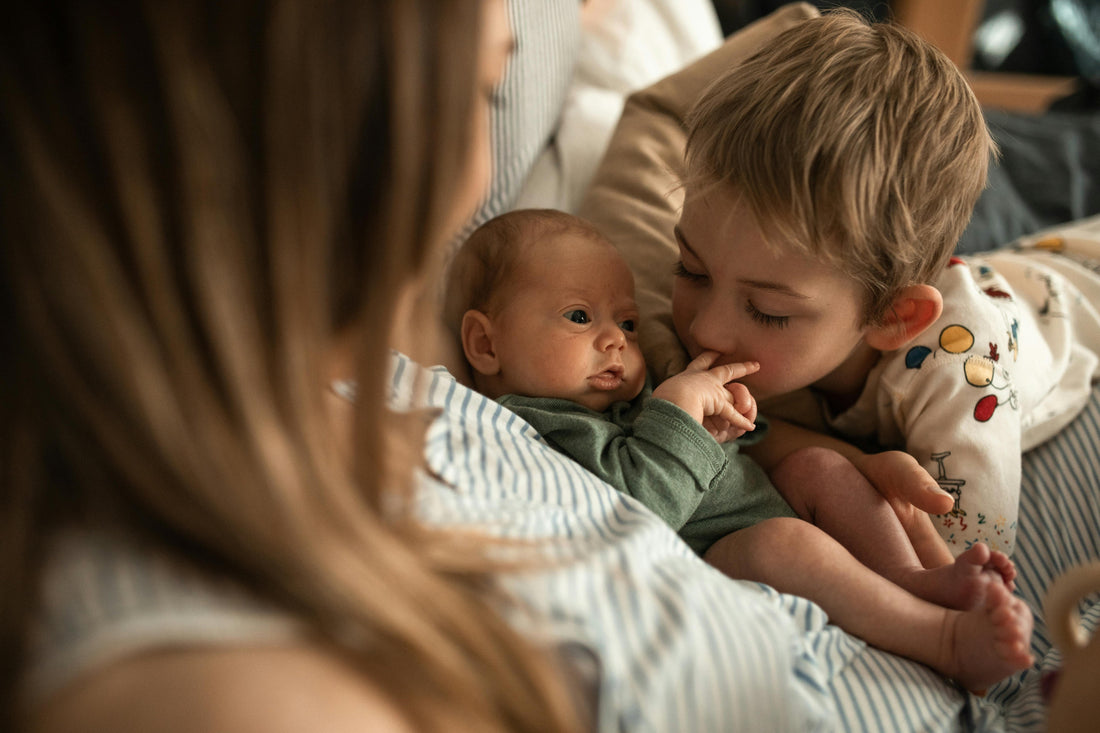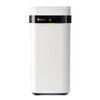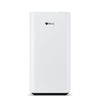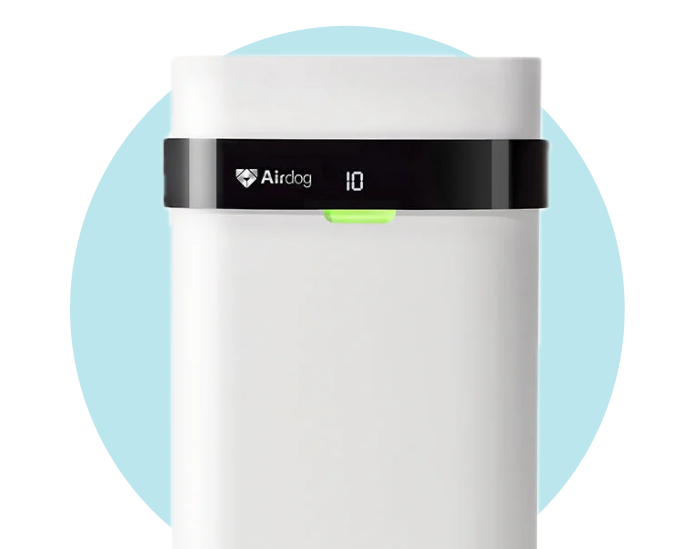Did you know that the air quality inside your home can be two to five times more polluted than the air outside? This startling fact becomes especially concerning when we think about the smallest, most vulnerable members of our families: our babies. Their delicate respiratory systems are far more sensitive to pollutants such as dust, pollen, pet dander, and VOCs, making clean air not a luxury but a necessity.
This guide promises to be an indispensable resource for parents navigating the crowded market of air purifiers. We will dissect the essential aspects of selecting the ideal air purifier for a baby's room, focusing on filter types, noise levels, and additional features that contribute to creating a clean, healthy environment conducive to their health and development.
Air purifiers have transitioned from being a niche luxury to a household staple for most . but the air purifier market can be difficult to sift through. Here are a few factors to consider::
-
Filter Types: The significance of a filter's ability to trap fine particles and the importance of choosing a purifier that does not emit harmful by-products like ozone.
-
Noise Levels: Understanding how a purifier's noise level can affect a baby's sleep quality and why opting for models with a 'silent mode' is beneficial.
-
Additional Features: Exploring smart features such as air quality sensors and automatic adjustments, which add convenience and ensure the purifier operates at its best when needed.
Selecting the right air purifier encompasses more than ensuring clean air; it's about fostering an environment that supports a baby's health and development.
The Primary Function of Air Purifiers
Air purifiers serve to create a sanctuary where the air is as pure and safe as possible. For a baby's room, the stakes are even higher due to their developing lungs and immune systems. Here's why:
-
Airborne Pollutants: Dust, pollen, pet dander, and volatile organic compounds (VOCs) are just a snapshot of the pollutants that an air purifier aims to eliminate. These particles can trigger allergies, asthma, and other respiratory issues in infants, making the air purifier's role critical.
-
Protection Against Illness: By removing harmful pathogens from the air, air purifiers can also play a part in reducing the likelihood of illnesses, which is particularly important for babies with their developing immune systems.
Understanding CADR and Its Relevance
The Clean Air Delivery Rate (CADR) is a metric that measures the volume of clean air an air purifier produces per minute. It's a crucial factor to consider, exemplified by models like the Coway Airmega AP-1512HH Mighty:
-
Performance Indicator: A higher CADR rating indicates a more efficient air purifier. For a baby's room, you want a model that can quickly and effectively clean the air, minimizing the baby's exposure to pollutants.
-
Size and Efficiency: CADR also helps you match the purifier to the room's size, ensuring the air purifier operates efficiently. This ensures that the baby's room has continuous access to clean air without the machine being overburdened.
The Downside of Ionizers and Ozone
While ionizers in air purifiers can help remove pollutants, they come with a significant downside:
-
Ozone Production: Some ionizers produce ozone as a by-product, which can exacerbate respiratory conditions such as asthma. For babies, whose respiratory systems are still developing, exposure to ozone can be particularly harmful.
-
Choosing Ozone-Free Models: It's imperative to select air purifiers that do not emit ozone. Ozone-free models ensure that while you're cleaning the air of pollutants, you're not introducing a new hazard into your baby's environment.
Key Features to Look for in an Air Purifier for Baby
When ensuring the health and safety of your baby, the air they breathe takes top priority. Air purifiers stand as silent guardians, but not all are created equal, especially when it comes to providing for a baby's unique needs. Below, we delve into the critical features to seek out in an air purifier for your baby's room, from filtration technology to noise levels and smart functionality.
Filtration Capability for Capturing Fine Particles
HEPA Filters
HEPA, or High-Efficiency Particulate Air filters, trap particles as small as 0.3 microns with a 99% efficiency rate. Most filters on the market use this technology (originally created in the 1940s) as it can capture many of the harmful pollutants found in our air.
While HEPA filters effectively remove a majority of harmful pollutants from the air, they can have a negative effect when not constantly replaced. Over time, HEPA filters become clogged with particles that have proven to create a harmful hotbed of bacteria, exacerbating the problems you may be experiencing. With many of these non-recyclable HEPA filter replacements costing $50-$150 each, it’s essential to consider alternative options that do not cost such a hit to your wallet and to the environment.
Airdog’s Two-Pole Action (TPA®) Technology
While traditional purifiers rely on disposable, non-recyclable HEPA filters that can clog and slow down over time, Airdog’s advanced Two-Pole Action (TPA®) technology ensures a faster and more effective purification process.
TPA® filters have the ability to eliminate particles as small as 0.0146 microns (20x smaller than the typical HEPA filter), capturing harmful viruses like influenza, rhinovirus, smog and other ultrafine particulates that HEPA filters cannot reliably capture.
In addition, Airdog’s filtration system is hand-washable. It doesn’t rely on non-recyclable, costly filter replacements. Learn more about Airdog’s filtration technology here.
Noise Level: The Importance of Silent Mode
A baby's sleep is precious, and maintaining an undisturbed rest is essential for their growth and well-being. Therefore, the air purifier you choose should not only be effective but also whisper-quiet. Look for models that have:
-
Minimal noise output, allowing your baby to sleep peacefully without the distraction of a running machine.
-
Adjustability, offering the option to reduce the operational sound during nap times or through the night.
Smart Features for Enhanced Air Quality Management
Smart features in air purifiers add a layer of convenience and efficiency. These intelligent systems provide:
-
Air quality sensors that detect changes in the environment and automatically adjust the purifier's settings to maintain optimal air quality.
-
Automatic adjustments based on real-time air quality readings, ensuring the room stays pollutant-free without manual intervention.
-
Remote control and monitoring through smartphone apps, allowing for seamless operation and peace of mind, even when you're not in the same room.
Size and Placement for Optimal Air Purification
The effectiveness of an air purifier is not just about its technology but also where and how it's used. Consider the following:
-
Appropriate sizing ensures the air purifier can cycle through the air in the room efficiently and effectively, based on the square footage.
-
Strategic placement away from obstructions and in a position that allows for unimpeded air flow, ideally near the baby's crib but not directly over it, to ensure the cleanest air surrounds your baby.
Selecting the right air purifier for your baby involves more than just picking a device off the shelf. It requires a thoughtful consideration of what makes an indoor environment safest for young, developing lungs. By prioritizing the most effective filtration systems, low noise levels, smart functionality, and proper sizing and placement, parents can make an informed choice that safeguards their baby's health and ensures a pollutant-free nursery.
Addressing Common Concerns and Misconceptions
The Ozone Question: Understanding Ionizers
A prevalent concern among parents revolves around the potential for ozone production by air purifiers, particularly those featuring ionizing functions. Ozone, while effective at neutralizing certain pollutants, can exacerbate respiratory conditions like asthma.
-
Banner Health Advisory: According to Banner Health, while air purifiers serve to improve indoor air quality, certain types, specifically older ionizers, can generate ozone as a byproduct of their operation. This has raised valid concerns regarding their suitability for environments inhabited by individuals with respiratory sensitivities, including infants.
-
Seeking Ozone-Free Options: For a baby's room, the emphasis should lie on selecting air purifiers that do not produce ozone. Many modern air purifiers now deploy HEPA filtration, coupled with activated carbon filters, to capture pollutants without emitting harmful byproducts.
Demystifying Air Purifier Maintenance
Another area rife with misconceptions is the maintenance of air purifiers, specifically regarding the frequency of filter changes and general upkeep. Proper maintenance is crucial not only for the device's efficacy but also for its longevity.
-
Follow Manufacturer Guidelines: Each air purifier comes with a set of manufacturer recommendations for filter replacement and maintenance. Adhering to these guidelines ensures the unit operates at peak efficiency, providing the best possible air quality for your baby's room.
-
Maintenance Misconceptions: Maintenance directly impacts the effectiveness of your air purifier—if HEPA filters are not replaced frequently, they can actually cause detrimental effects to your health. Some units like Airdog’s filters feature washable and reusable filters, further reducing maintenance costs and effort.
Balancing Cost and Quality
When it comes to selecting the right air purifier for a baby's room, the balance between cost and quality emerges as a critical consideration. Higher-priced models often come with advanced features and superior filtration technologies, which can offer better long-term value and effectiveness.
-
Investing in Quality: Opting for models with robust build quality, efficient filtration systems, and user-friendly features can result in significant long-term savings. These units tend to last longer and perform more effectively, reducing the need for frequent replacements or repairs.
-
Sophisticated Filtering Technologies: Higher-end air purifiers often incorporate sophisticated technologies, such as smart sensors that adjust filtration based on real-time air quality readings. This not only enhances the unit's effectiveness but also optimizes energy consumption, contributing to lower operational costs over time.
By prioritizing air purifiers that align with these considerations, you can create a healthier, more conducive environment for your baby's growth and well-being.
Conclusion
The Importance of Selective Choice
Choosing the right air purifier for your baby's room goes beyond just purchasing a device; it involves making an informed decision that contributes significantly to creating a healthy living space. Remember:
-
Filtration Technology: Opt for air purifiers equipped with technology that is capable of capturing the finest of harmful particles, allergens, and other pollutants detrimental to your baby's respiratory health.
-
Noise Levels: Consider models with a silent mode feature to ensure your baby's sleep remains undisturbed, reinforcing the importance of a quiet operation for a peaceful nursery environment.
-
Smart Features and Size: Evaluate the benefits of smart features for automatic air quality adjustments and ensure the purifier's size is appropriate for your baby's room, following manufacturer's guidelines for optimal air purification.
Long-term Health Benefits
Investing in a high-quality air purifier represents a commitment to your household's overall well-being, offering benefits that extend beyond the immediate needs of your baby's nursery.
-
Reduced Allergy and Asthma Triggers: By removing airborne particles, a good air purifier can help minimize triggers for allergies and asthma, promoting better respiratory health for everyone in the home.
-
Improved Sleep Quality: Clean air contributes to better sleep quality for your baby and all family members, thanks to the removal of pollutants that can irritate the respiratory system during the night.
-
Longevity and Durability: High-quality air purifiers are designed to last, providing your family with years of reliable air purification. This durability ensures that your investment continues to protect your home's air quality over time, offering peace of mind and reduced need for frequent replacements.
This is an investment in your child's health, comfort, and the broader environmental quality of your home. As you navigate the options, let the outlined features, comparisons, and the promise of long-term benefits guide your decision-making process.





